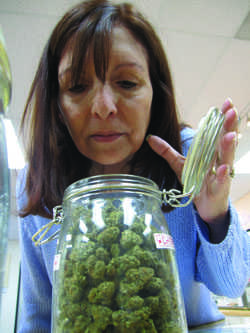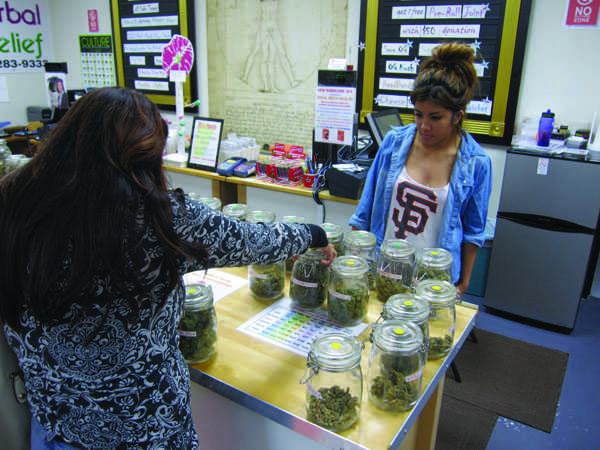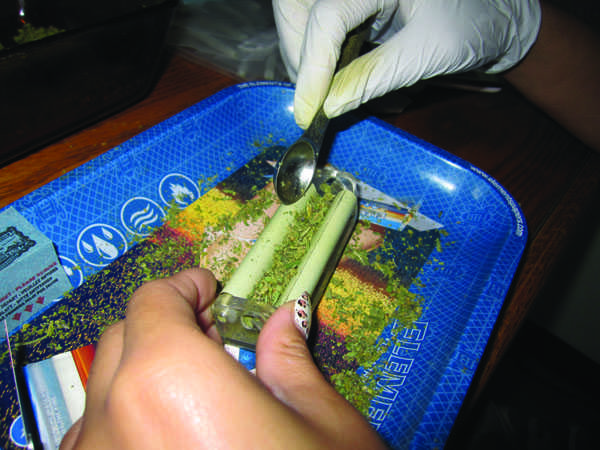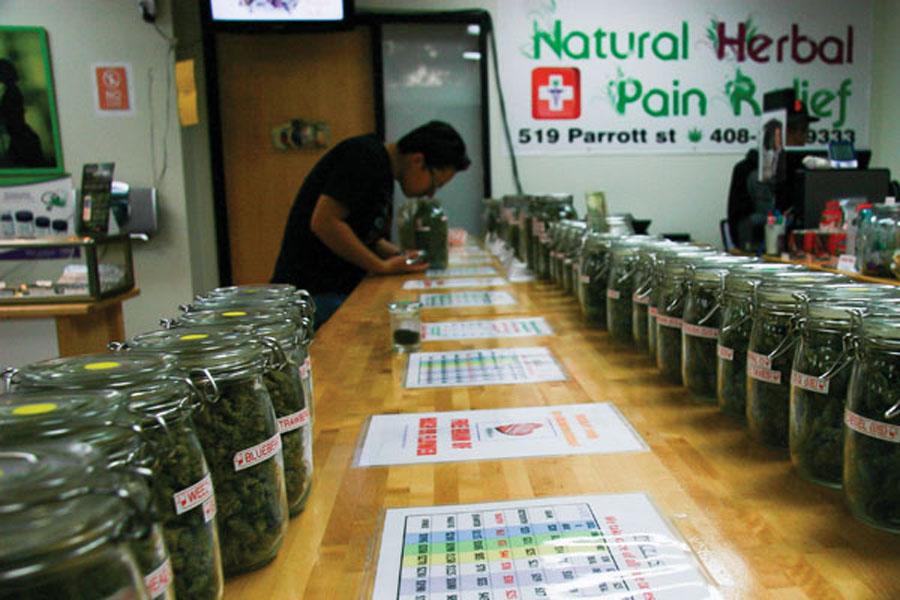Emma enters her daughter’s room holding two sandwich bags, each bearing five grams of marijuana in dime-sized green buds. She hands one bag to her daughter, Liz, a former Palo Alto high school student whose name has been changed.
Liz rolls her eyes, and Pete sniffs a handful of his marijuana before placing it in his backpack.
“Careful,” Emma says. “Your mom isn’t going to smell it on you, or anything?”
Peter shakes his head and walks outside.
Emma takes a pinch of marijuana out of Liz’s bag, placing it on the table. After a moment’s hesitation, she puts another pinch down.
“Thanks Mom,” says Liz, “That’s all you need,” Emma says, and exits the room, taking Liz’s bag.
Liz places the marijuana in her pipe and lights up, breathing in deeply and exhaling a stream of smoke.
Though she is still a minor, Liz relies on marijuana for holistic medication, which helps her combat stress, depression and a sleeping disorder. In the past, Liz often bought off the street illegally. Since then, her mother convinced a doctor to provide her with a medical card for stress and sleep deprivation. With it, Emma is able to illegally supply her daughter with legally bought marijuana.
She is also able to fuel the habit of Pete, an underage marijuana user.
In the two bags of weed lies the dilemma inherent to medical marijuana: How can marijuana be channeled to people like Liz, who has genuine health problems, without being open to abuse from those like Pete, who use it purely for recreation?
Jerry Berkson, assistant principal at Palo Alto High School, says that if a student is caught with marijuana they will be suspended for five days, and have the option of going through a rehabilitative program. However, Berkson is not against medical marijuana.
“If pot is legitimately diagnosed by a doctor, and not one of those guys who sells a card for 50 bucks, then it should be allowed,” Berkson says. “My hope is that the doctor will look to other avenues of treatment, rather than just giving a kid the green light to get high all the time.”
Marijuana Legalization
Under the Compassionate Use Act of 1996, California physicians can legally prescribe marijuana as a recommended medication for certain patients. Nineteen other states and the District of Columbia have passed similar bills.
Advocacy of legalizing medical and recreational marijuana has been gaining momentum; enough, it seems, that California, and perhaps the rest of the nation, may be poised to pass laws legalizing recreational pot sometime in the next decade. Colorado and Washington already have.
Since early February, two bills, the Ending Federal Marijuana Prohibition Act and the Marijuana Tax Act, have been awaiting approval from Congress. Together, in addition to decriminalizing pot, the two bills would effectively allow both state and federal governments to rake in revenue from the virtually untapped marijuana industry, worth upwards of $6 billion dollars, according to Harvard economist Jeffrey Miron, who also estimates that the federal government would save almost $8 billion dollars in marijuana enforcement costs.
While California’s 2010 proposed marijuana measure, the Regulate, Control & Tax Cannabis Act, did not pass, a Tulchin Research survey found that nearly two-thirds of California voters (65 percent) support a proposal to legalize, regulate and tax marijuana in California for adults. Nearly half of voters (46 percent) strongly support legalization.
Palo Alto, along with over 180 other cities in California, bans cannabis dispensaries. However, the ban has not prevented many citizens, including students, from obtaining marijuana, both for medical and recreational purposes from nearby cities.
Liz
Liz started smoking marijuana around the age of 12, and although she used it recreationally at first, she says she now consumes it mostly for medical purposes.
Her illness, recurrent isolated sleep paralysis, a result of misfiring neurons, disrupts REM sleep and causes victims to lose muscle control while sleeping, essentially paralyzing them. Other symptoms include vivid and often frightening hallucinations, which can last for over an hour.
“It feels like a switch, where you are pushed down on your chest and you start hearing crazy things,” says Liz, who remembers first experiencing RISP at age four. “It’s like in a horror movie where there is this deep voice, a medium voice and a high voice, and they’re all whispering at the same time. It feels like my hands are stuck in concrete and my ears are stuffed with cotton, and I am slowly sinking under water.”
Small doses of antidepressants Zoloft and Selective Serotonin Reuptake Inhibitor usually treat RISP, but severe cases like Liz’s require a higher dosage, which heightens the drug’s negative side effects.
“The pills make me slower, and I feel gross and groggy and tired,” Liz says. “It’s so bad that the next day I won’t want to get out of bed. The only time I have been able to evade the effects of RISP is when I smoke.”
Liz smokes daily to fight regular nausea and vomiting. Unable to obtain medical marijuana legally as a minor, Liz receives marijuana illegally from her mother twice a week, sometimes bought from the street, other times from a dispensary.
“My mom advocates for me to get a card,” Liz says. “She believes it is a medication, and she doesn’t approve of other drugs.”
Liz is working to get a medical card, despite the fact that she is only 17 years old. With her mother’s permission, she will go through a series of evaluations to determine if her disorders can be treated legally by marijuana and, if so, what cannabis strains would be best for her.
Marijuana as Medicine?
This October, California Lt. Gov. Gavin Newsom announced that he would head an American Civil Liberties Union Committee to monitor the effect of recreational marijuana legalization in Colorado and Washington. The committee will publish a series of research papers, designed to provide policy makers with a clear understanding of how to implement potential marijuana legislation.
Nevertheless, the sale or prescription of marijuana remains prohibited under the federal Controlled Substances Act of 1970, which classifies drugs on a scale of five schedules. Along with LSD and heroin, Marijuana is a Schedule I drug — considered the most dangerous and likely to be abused.
The DEA defines Schedule I drugs as having “no currently accepted medical use in treatment in the United States.”
In contrast, cocaine, methamphetamine, opium and morphine are classified as Schedule II drugs — less harmful than 9 percent addictive marijuana in the eyes of the DEA — giving rise to accusations that the federal government is too stringent in its regulation of marijuana.
Some research — not all conclusive — has demonstrated marijuana’s potential as a source ameliorative care for those suffering everything from neuropathic disorders to intense pain. Others have found a correlation between long-term marijuana use and a decrease in professional motivation, impeded judgment and impaired brain development in adolescents users.
“People say it’s a victimless crime,” says Mike Rogers, a Republican Congressman from Michigan and Paly parent. “But if you jump in a car impaired and cause an accident, or become less productive in your work, those actions have very tangible effects on others around you.”
Rogers says that for everything, there is a consequence, and that for marijuana in particular, the consequences are yet to be fully realized.
“Once legal, people will try and sell it to you, to encourage you to use marijuana — it’s a business,” Rogers says. “THC levels will go up and, as they get higher, so will the impact marijuana has on the human brain.”

Natural Herbal Pain Relief
The room is replete with marijuana in glass jars; edibles fill the racks, and the hum of rap music hangs in the air mingling with the smell of weed. Rows of cannabis products of all colors and types line the counters.
This is no Seth Rogen fantasyland; it’s the Natural Herbal Pain Relief clinic, a medical marijuana dispensary at 10th and Parrot Street in San Jose, one of more than 100 cannabis clinics in the city. Inside the lobby, a television plays a documentary detailing the history of medical marijuana in mildly euphemistic terms.
Medicine lies in jam pots stamped with titles like “Dream Queen,” “Trainwreck,” “Fruity Pebbles” and “L.A. Confidential” — donations from the clinic’s patients.
“We are a collective community,” says manager Reyna Burns, 34, who first came to NHPR as a client four years ago. “Patients grow their own medication, and give us their surplus; it’s a symbiotic relationship.”
Burns has worked in the medical marijuana industry since 2010. Suffering from Attention Deficit Disorder and insomnia, Burns and has been prescribed a variety of medications. Four years ago, she obtained her marijuana card and felt an immediate improvement.
Burns estimates that most of NHPR’s patients with significant health problems try 10 or 15 different medications before lowering their dosages to five or six pills with cannabis.
Although marijuana has often been considered a gateway drug, Burns says that as long as people use marijuana for medical purposes, it will not open doors to more serious addictions.
“I believe in legalizing marijuana completely,” Burns says. “It will be a gateway drug as long as it’s in the same category as crystal meth, cocaine and LSD. If you take it out of the characteristic of other drugs and classify it as a medicine, then it will lose its allure. It’s not as much fun for people seeking illicit activities.”

However, Rachna Singh, a doctor at San Jose medical marijuana evaluation center Greenway Compassionate Relief, says marijuana use should only be legalized as a medicine, and not a recreational drug.
“Doctors must be the regulators— otherwise anyone will be able to walk in to a dispensary and buy pot,” says Singh, who has never smoked pot. “A free-for-all would be like the 60s or 70s, where marijuana would be used and abused. If it is legalized completely then dispensaries will lower their standards because they will not have to follow as strict rules to keep their license [and] will have to face stiffer competition from the streets, providing yet another incentive to lower their standards.”
Singh says patients can access legally purchased marijuana if the doctor feels they are telling the truth.
“If someone comes to us and says, ‘I cannot sleep,’ we can’t tell if they are lying,” Singh says. “People need to bring records, showing documentation of their problems.”
“We make them fill out a history form with all the conditions they have and how they feel that marijuana will help,” says Singh, who sees about 20 patients a day. “Then we check their social history and their family history; can it be confirmed that this patient has legitimate health problems?”
Not all receive a card, either because they fail to bring the necessary materials or, more likely, because their records reveal high potential for drug abuse.
Congressman Rogers points to alternative pills such as MARINOL, which contains THC extracts, and CB1 activators, which activates the same brain receptors as THC in marijuana.
“What people don’t realize is they can get the THC component, as well as any other chemical compound found in marijuana, in pill form,” Rogers says. “So you don’t really need to prescribe medical marijuana. In fact, I think the issue goes well beyond the notion of medical marijuana. I think that most people who push medical marijuana just want to smoke whenever and wherever they want.”
However, at least in Singh’s opinion not all patients appear to be those who simply want to get “high.”
Singh describes most of her patients as men between their mid-20s and 40s, educated professionals coming from “mega-companies” in Silicon Valley who suffer from high levels of stress in their professional lives.
Still, the guidelines set in place have not prevented Paly students from obtaining medical marijuana, whether by purchasing cards or through friends.

“Compared to other medications, marijuana provides me with instant relief and results,” Anne says. “I can control the effects it has on me; it can let me know whether I want more or less.”
In her youth, before medical marijuana was legalized, Anne smoked recreationally. Now, Anne uses marijuana as a way to palliate the stress of the many responsibilities in her life.
“It’s not really accepted for most older professionals,” Anne says. “Most people keep it hidden. I see people on break with cigarettes, and I wish I could do that with marijuana, and then go back in and work again.”
Anne has been coming to Natural Herbal Pain Relief for over two years now, spending roughly $160 a month on marijuana and cannabis products.
“I see it as a glass of wine, but better,” Anne says. “Alcohol and medicine give me a hangover versus when I smoke, it’s natural and has all these different benefits, which I would normally need to take several medications to receive.” Photo by Jack Brook.
Jacob
Jacob, a Paly student, used to get his marijuana from “Dirty Van Dan,” a small-time dealer who sells weed out of his truck in East Palo Alto.
Then, on his 18th birthday, Jacob received his medical marijuana card. He says he uses marijuana to soothe pain from a herniated disc, the result of a sports injury from which Jacob never fully recovered.
Though he says he uses his card for legitimate health reasons, Jacob confesses that he would have applied to get one even if he didn’t need it for medical purposes. He also contends that, while one or two students a week approach him asking him to buy them marijuana, he hasn’t sold it to anyone outside his friend group since getting a card.
“If I am with a group, then I let them use it [his marijuana],” says Jacob, who reports spending $60 to $80 a month on marijuana and related products. “But otherwise, it’s not worth giving it to people.”
He admits that at first his parents were “pissed” when they learned he was getting a card but, in the end, Jacob knew that they couldn’t legally do anything about it.
“Eventually, my parents just gave up,” Jacob says. “I have great grades and I know I am going to get into a good college. Really, there is no proof that marijuana has been affecting my life in a negative way.”
However, not everyone is able to balance marijuana well with the rest of their life.
“I had buddies from high school who smoked a lot of pot and later went to rehab for harder drugs,” Berkson says. “But some went on to become doctors.”
One of Berkson’s friends ended up with a cocaine addiction.
“I can’t guarantee marijuana was a gateway, but it’s such a stepping stone — most people are no going to just walk up and try cocaine.”
Jacob feels that marijuana faces an undeserved stigma in society, from parents in particular. He says that while most parents believe cigarettes to be worse than marijuana, they still view alcohol as a lesser offense.
“The irony [of alcohol and cigarettes being legal] is that alcohol and cigarettes are much more dangerous,” Jacob says. “But because they have always been socially acceptable in the past, they have less of a negative connotation than marijuana.”
Marlon
Marlon Jackson, 52, is a half-Klamath Modoc Native American, with a long, black, braided ponytail and white sideburns. His voice is hoarse — he attended a “Big Lebowski” festival the night before talking with Verde.
Raised in Humboldt County, “ground zero” for marijuana growing in the 70s and 80s, Jackson was soon sucked into the growing culture, starting a marijuana grow-operation with a few friends to supply them with enough marijuana to smoke all year.
From 1979 to 1986, Jackson would spend a week at a time in the remote camp-site, caring for his marijuana plants.
The most Jackson and his friends ever grew was 40 plants — enough for themselves, and other friends, and even to pay rent. Compared to other growers’, Jackson’s camp was a small operation, but it still attracted the attention of authorities
Spotter helicopters frequently scoured Humboldt County, looking for grow-ops. Jackson recalls a close brush with a helicopter in his own camp.
“I tried to run away through the trees,” Jackson says. “But it was so bare that they were able to follow me. Eventually, I just sat down, like, ‘Okay, you got me.’ But then the helicopter went away, and never came back.”
Eventually, Jackson finished college and began a career as an engineer. He thought he’d put his marijuana days behind him. But in the late 1990s, his wife, Sonnie, started having severe stomach problems, the result of an early gastric-bypass surgery.

“They would cut almost all of your stomach lining out,” Jackson says.
She lost almost 75 percent of her body mass, and was no longer wanting food. She was slowly starving herself, Jackson says
Doctor’s prescribed Sonnie powerful, “chemotherapy level” anti-nausea pills, such as Zofran, but Jackson says they were “ridiculously expensive” and had terrible side effects. Desperate, Sonnie tried pot.
“We were skeptical at the start,” Jackson says. “But then she started eating. After a few months, we were able to get her off of those pills. When she took the anti-nausea pills, she was getting headaches, so they would give her Imitrex for the headaches. And then her Imitrex was causing her not to sleep, so they would give her Ambien to make her sleep — she was taking over 10 pills a day. All of that went away by switching her over to medical marijuana.”
After receiving a prescription from a doctor in 1997, Jackson and his wife now grow a few plants each year in their backyard, enough for whenever Sonnie’s nausea flares up.
Jackson says that if he were to guess, he would say that 80 percent of those with a medical marijuana card do not have medical needs, or at least enough to warrant a card.
“Yeah, a lot of people are abusing the system,” Jackson says. “But to have it illegal to start with is sort of silly. It’s virtually legal right now — having it fully legalized would probably not lead to much of an increase in users, just eliminate a lot of the bureaucracy involved.”
Congressman Rogers, on the other hand, says that before society embraces marijuana completely, they must look to the host of unforeseen consequences.
“[Marijuana] is not what’s made America a prosperous country,” Rogers says. “Going away from hard work and personal responsibility — it’s disconcerting.”
Rogers says that if marijuana were to become largely legal, people would find a way around the regulations set in place, leading to a widespread abuse.
“There will be a slowly and steadily rising social cost — that’s what happens in drug cultures,” Rogers says. “Of course, dosage will increase over time. Communities will have to decide if that’s who they want to be. At some point, the pendulum will need to swing back.”
Like Rogers, Jackson foresees serious problems in regulating marijuana.
“If you take a blood test, you are unable to tell if someone is so high that they can’t drive, having just smoked a bunch of marijuana, or if they haven’t smoked any but it’s still in their system,” Jackson says. “It’s going to be hard to tell with things like driving under the influence.”
Ultimately, Jackson sees marijuana as serving a social function, similar to alcohol.
“I would like to see marijuana, at least as far as recreational use among adults, as something where you can come home from work and vaporize a little bit of marijuana — that would be the same as having a glass of wine,” Jackson says. “And just like light, social drinking, adults should be able to enjoy light, social marijuana use.”
Regardless of what it is used for, marijuana will always be readly available to those who seek it.
“People are always going to want substances that they can’t have,” Liz says. “And if there is a way for them to get it legally, safely, we might as well go with it, since it is better than the alternative.”



